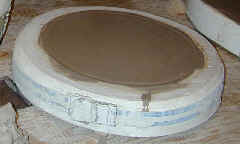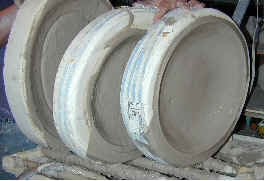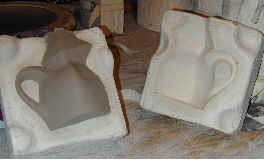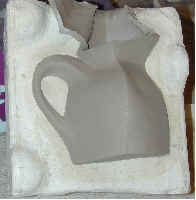 Figure 1: Here is a one-piece plate mold filled with casting slip. |
Page 1
go to Page 2 go to Page3 (supplies) go back to home page |
Eleanora Eden |
 Fig 2: Here are plate molds draining On top of the slip-mixer. |
A SIMPLE DESCRIPTION OF PLASTER CASTING While the process of wheel-throwing is widely understood, the process of plaster-casting remains a mystery to many people. Here is a brief description of how a casting is made from a mold. If you fill a thick, dry plaster “bowl” , or mold, with liquid clay, which is called “slip”, the plaster will start to absorb the liquid from the clay and a skin of solid clay will adhere to the plaster. This “skin” will thicken over time as more moisture is absorbed by the plaster. When the desired thickness is attained the rest of the liquid clay is poured off and this “skin” of clay adhering to the plaster will dry and loosen itself from the plaster mold. When removed it retains every nuance of shape of the plaster. This, then, is a slip-casting from a one-piece mold. . Molds for complicated shapes can require more pieces that are keyed together to fit snugly to hold the liquid clay. There always has to be a place for the slip to get in and out, and there has to be at least a bit of reservoir for the slip. As the moisture from the slip is absorbed by the plaster the level of the slip is lowered. If it drains down below the top of the casting then that part of the casting will be too thin. Also notice that this mold doesn't have an extra bottom piece. The seam runs diagonally across the bottom of the pot Also notice the large lugs that key the two pieces of the mold together. This is so that when the two mold pieces go together they will always be positioned correctly. Small protuberances can sheer off or wear down. When planning a 2-piece mold thought has to be given to how it will be keyed. go to Page 2 go to Page3 (supplies) go back to home page |
|
 Here in figure 3 is a pitcher casting before it is removed from its mold. The 2-piece mold has already been split apart and the casting is ready to be removed. |
||
 In figure 4 I have cut away part of the opening, sometimes called the sprue hole. This is the reservoir for the slip. |
||